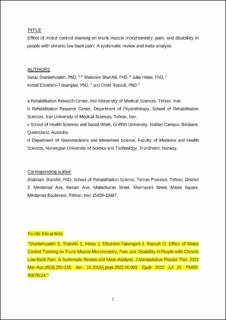| dc.contributor.author | Shanbehzadeh, Sanaz | |
| dc.contributor.author | ShahAli, Shabnam | |
| dc.contributor.author | Hides, Julie | |
| dc.contributor.author | Ebrahimi-Takamjani, Ebrahim | |
| dc.contributor.author | Rasouli, Omid | |
| dc.date.accessioned | 2023-05-09T14:56:45Z | |
| dc.date.available | 2023-05-09T14:56:45Z | |
| dc.date.created | 2022-07-23T10:29:33Z | |
| dc.date.issued | 2022 | |
| dc.identifier.citation | Journal of Manipulative and Physiological Therapeutics. 2022, 45 (3), 202-215. | en_US |
| dc.identifier.issn | 0161-4754 | |
| dc.identifier.uri | https://hdl.handle.net/11250/3067365 | |
| dc.description.abstract | Objective The aim of this systematic review and meta-analysis was to study the effects of motor control training (MCT) on trunk muscle morphometry measured by ultrasound imaging and pain and disability in individuals with chronic low back pain. Methods PubMed, Web of Science, Scopus, and Cochrane Library databases were searched from study inception until January 2021. Randomized control trials evaluating both muscle morphometry and pain or disability in individuals with chronic low back pain were included. Study selection, data extraction, and quality assessment were performed by 2 reviewers independently. Modified Downs and Black tool and the Grading of Recommendations Assessment, Development and Evaluation approach were used to assess the risk of bias and quality of evidence, respectively. A meta-analysis was performed using a random effects model with mean difference or standardized mean difference (SMD). Results Of 3459 studies initially identified, 15 studies were included, and 13 studies were selected for meta-analysis. The results revealed no differences in the resting thickness of the transversus abdominis, internal and external oblique, and lumbar multifidus muscles in studies that compared MCT with other interventions. The transversus abdominis muscles contraction ratio was greater (SMD = 0.93; 95% confidence interval [CI], –0.0 to 1.85) and lower pain (weighted mean difference: –1.07 cm; 95% CI, –1.91 to –0.22 cm; P = .01) and disability (SMD = –0.86; 95% CI, –1.42 to –0. 29; P < .01) scores were found in the groups who underwent MCT compared with other interventions. Conclusion This systematic review and meta-analysis found that motor control exercise training increased the transverse abdominis contraction ratio (muscle activation) and improved the level of pain and disability compared to other interventions in people with chronic low back pain. However, motor control exercise training was not superior to other interventions in increasing the resting thickness of deep abdominal and lumbar multifidus muscles in intervention times less than 12 weeks. | en_US |
| dc.description.abstract | Effect of Motor Control Training on Trunk Muscle Morphometry, Pain, and Disability in People With Chronic Low Back Pain: A Systematic Review and Meta-Analysis | en_US |
| dc.language.iso | eng | en_US |
| dc.publisher | Elsevier | en_US |
| dc.title | Effect of Motor Control Training on Trunk Muscle Morphometry, Pain, and Disability in People With Chronic Low Back Pain: A Systematic Review and Meta-Analysis | en_US |
| dc.title.alternative | Effect of Motor Control Training on Trunk Muscle Morphometry, Pain, and Disability in People With Chronic Low Back Pain: A Systematic Review and Meta-Analysis | en_US |
| dc.type | Peer reviewed | en_US |
| dc.type | Journal article | en_US |
| dc.description.version | acceptedVersion | en_US |
| dc.source.pagenumber | 202-215 | en_US |
| dc.source.volume | 45 | en_US |
| dc.source.journal | Journal of Manipulative and Physiological Therapeutics | en_US |
| dc.source.issue | 3 | en_US |
| dc.identifier.doi | 10.1016/j.jmpt.2022.06.003 | |
| dc.identifier.cristin | 2039187 | |
| cristin.ispublished | true | |
| cristin.fulltext | postprint | |
| cristin.qualitycode | 1 | |
